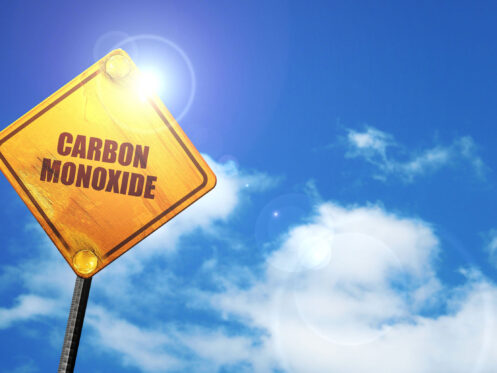If you’re a homeowner here in Frederick, MD, you likely know that the law requires the installation of carbon monoxide detectors in all homes built here since 2008. They’re such a common sight that plenty of people fail to appreciate what an important safety device they are. The reason for that is simple. It’s that carbon monoxide is lethal in sufficient concentrations, and it isn’t easy to spot the signs of carbon monoxide poisoning yourself. Absent an alarm, most people won’t notice a problem until it’s too late. To help change that, here’s everything you need to know about carbon monoxide. We’ll cover what it is, why it may be in your home and the physical symptoms of carbon monoxide poisoning that manifest as concentrations in the air rise.
What Is Carbon Monoxide?
Carbon monoxide is an odorless and colorless gas that results from incomplete combustion of carbon-based fuels. Chemically, it’s made up of a single carbon atom and a single oxygen atom bound together. Although that may seem like a benign combination, it is anything but. When humans breathe in carbon monoxide, it replaces the pure oxygen in our bloodstream. This starves the body of the oxygen it needs to function. In other words, breathing carbon monoxide causes you to suffocate slowly.
What Are the Common Sources of Carbon Monoxide?
There is a variety of common carbon monoxide sources that may be present in your home. This is the reason that carbon monoxide detectors are now standard equipment in homes. It’s because no matter how careful you are, it’s nearly impossible to eliminate every possible carbon monoxide source in your home. Common sources include:
- Automobile engines
- Fireplaces
- Charcoal grills
- Natural gas stoves
- Propane heaters
- Gas furnaces and water heaters
Common Symptoms of Carbon Monoxide Poisoning
Although it’s impossible to detect carbon monoxide yourself without the help of a purpose-built carbon monoxide detector, you can learn to spot the symptoms of carbon monoxide poisoning. If you notice any of the symptoms while you’re in your home, you should leave immediately. You should never try to locate the source of the carbon monoxide yourself. Nor should you try and ventilate your home to solve the problem. Instead, leave and call 911 from a safe location. The following are the most common symptoms of carbon monoxide poisoning.
- Shortness of breath
- Rapid breathing
- Chest pains
- Confusion
- Dizziness
- Drowsiness
- Nausea and vomiting
- Low blood pressure
It’s also worth pointing out that any pets in your home may suffer from similar symptoms if there’s carbon monoxide present. In many cases, they’ll show symptoms before you do, so it is important to monitor your pets as well. They may provide you with an early warning that something’s wrong.
Preventing Carbon Monoxide in Your Home
There are a variety of ways that you can prevent carbon monoxide from building up in your home. Most of them involve addressing the common source of carbon monoxide. Here are the best steps to take.
Regular Furnace Service
If your home has a gas furnace, you should have it professionally serviced by our expert HVAC technicians at least once per year. This is especially important if your home’s furnace is 15 years old or more. As gas furnaces age, the repeated expansion and contraction of their heat exchangers due to exposure to heat can lead to the formation of tiny cracks. Those cracks may allow carbon monoxide to seep into your home. They’re also not something that you’d notice on your own since a furnace’s heat exchanger is inside a sealed portion of your furnace. However, an inspection of the heat exchanger is a part of every furnace maintenance appointment. If our technician spots a problem, they’ll let you know so you can address it.
Regular Water Heater Service
It is also a good idea to have your gas water heater serviced once per year if you have one. A water heater service appointment will include a thorough inspection of your water heater’s heating elements and ignition systems. Problems with either can result in a carbon monoxide leak in your home.
Ensure Proper Appliance Ventilation
All of the gas-powered appliances in your home require ventilation to operate safely. In the case of a gas furnace, a flue pipe will carry exhaust gases out of your home. The same thing goes for gas water heaters and gas clothes dryers. It is important to make sure nothing obstructs the ventilation pipes coming from such appliances. It is also important to visually inspect them from time to time to look for any damage. If a ventilation pipe cracks or shows any deterioration at its joints, you should stop using the appliance immediately and call for a professional repair.
Install and Maintain Carbon Monoxide Detectors
It is also necessary to install carbon monoxide detectors in your home and follow their required maintenance schedule. Most carbon monoxide detectors are battery-operated and require replacement approximately every five years. Some more advanced models, including those that draw power from your home’s electrical wiring, may have rated service lives of up to ten years.
At a minimum, you should have at least one carbon monoxide detector installed in a central location on each floor of your home. This is especially important on any floor with a gas-burning appliance or fireplace. You should also have one near your home’s bedrooms. Ideally, you should have a carbon monoxide detector installed within 5 to 20 feet of each gas-burning appliance in your home. That can cut down the time it takes for you to get a warning when carbon monoxide starts building up in your home.
If you’re not sure where to place carbon monoxide detectors in your home, Markool Heating & Cooling can help. Our experts will help you figure out how many you need and where to put them. They can even install them for you if you don’t feel comfortable or confident in doing it yourself. That way, you and your family can rest easy in the knowledge that you’ll receive ample warning of the presence of carbon monoxide in your home.
Your Carbon Monoxide Detection Specialists
Markool Heating & Cooling is the best place to turn for all of your carbon monoxide detection needs in Frederick. Not only can we help you install and maintain carbon monoxide detectors, but we can also offer you maintenance services for your home’s gas furnace and water heater. Those are a part of our comprehensive HVAC installation, maintenance, and repair services, as well as our household plumbing services. You can count on our NATE-certified HVAC technicians to help safeguard your home against the danger of carbon monoxide. Plus, our long list of glowing, five-star customer reviews should let you know that we always go the extra mile to make our valued customers as happy as possible. So, if you have questions about carbon monoxide detection or need your gas appliances serviced, call Markool Heating & Cooling today!






